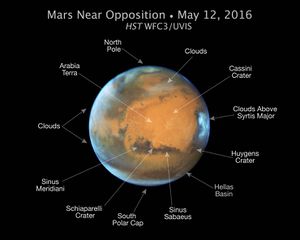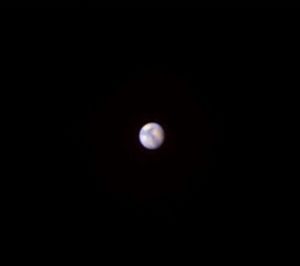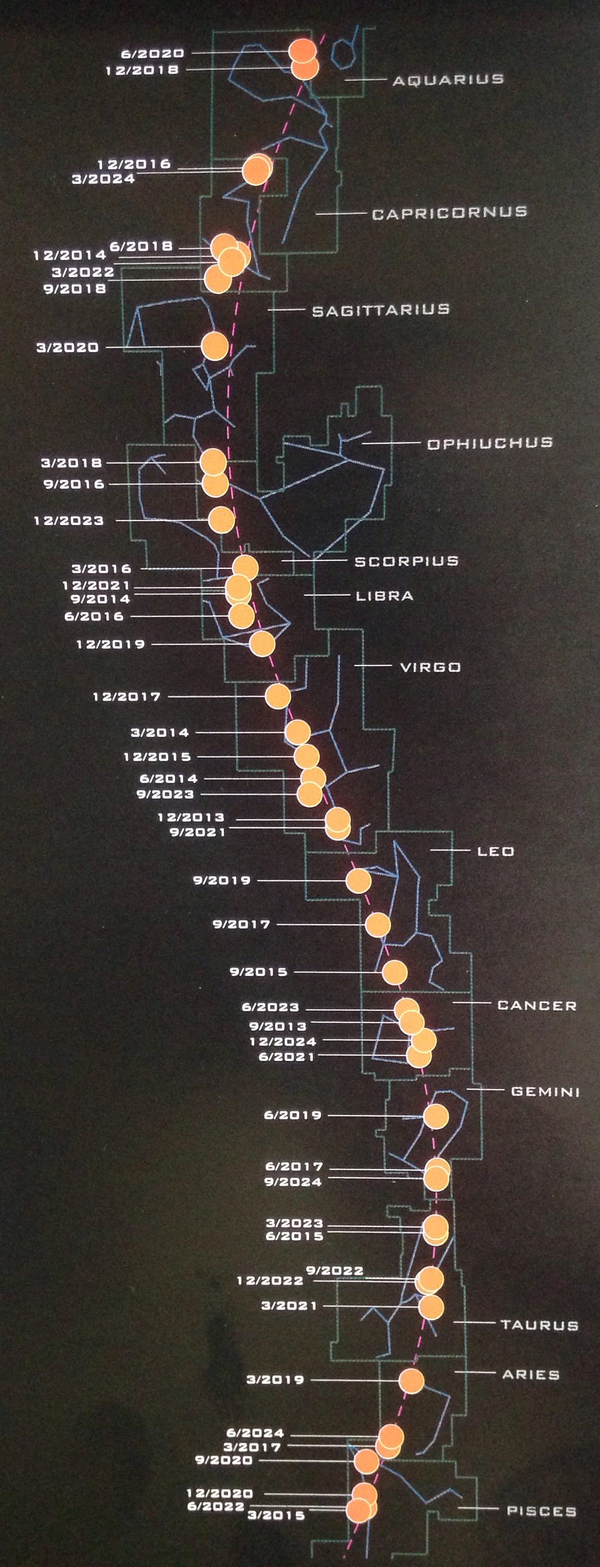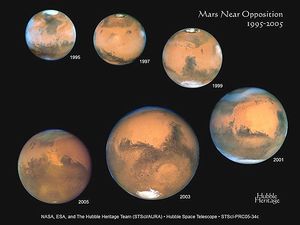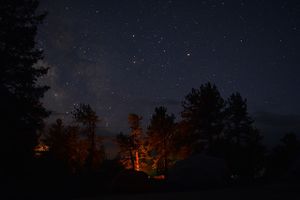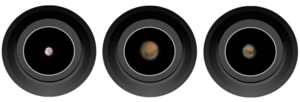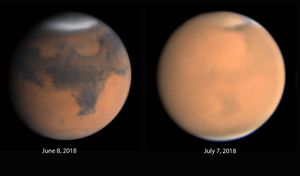Difference between revisions of "Observing Mars with a Telescope"
| Line 9: | Line 9: | ||
==When can Mars be seen?== | ==When can Mars be seen?== | ||
| − | [[File:MarsInZodiac.png|thumb|left|Chart depicting the progression of Mars through the zodiac constellations at three-month intervals over a period of 10 years. Gaps in the sequence indicate when Mars is too close to the Sun to be seen.]] | + | [[File:MarsInZodiac.png|600px|thumb|left|Chart depicting the progression of Mars through the zodiac constellations at three-month intervals over a period of 10 years. Gaps in the sequence indicate when Mars is too close to the Sun to be seen.]] |
[[File:OppositionConjunction.jpg|thumb|right|Diagram illustrating the relative positions of Earth and Mars at opposition and conjunction. The two planets reach opposition roughly once every 26 months.]] | [[File:OppositionConjunction.jpg|thumb|right|Diagram illustrating the relative positions of Earth and Mars at opposition and conjunction. The two planets reach opposition roughly once every 26 months.]] | ||
Timing plays an essential role in viewing Mars from Earth. The differing orbits between the two planets mean that Mars enters opposition—that is, the point where it and Earth are on the same side of the Sun and therefore at their closest approach—once every 26 months.<ref name=":0" /><ref name=":1">Sparrow, G. (2013). ''Constellations: A Field Guide to the Night Sky'' (First). Quercus.</ref> For the majority of the year, Mars appears fairly small in the sky, although not so small that it is invisible to the naked eye. During a window of several months before and after opposition, however, it appears brighter and large enough to make out surface features with the help of a telescope.<ref name=":0" /> | Timing plays an essential role in viewing Mars from Earth. The differing orbits between the two planets mean that Mars enters opposition—that is, the point where it and Earth are on the same side of the Sun and therefore at their closest approach—once every 26 months.<ref name=":0" /><ref name=":1">Sparrow, G. (2013). ''Constellations: A Field Guide to the Night Sky'' (First). Quercus.</ref> For the majority of the year, Mars appears fairly small in the sky, although not so small that it is invisible to the naked eye. During a window of several months before and after opposition, however, it appears brighter and large enough to make out surface features with the help of a telescope.<ref name=":0" /> | ||
| Line 47: | Line 47: | ||
[[File:TelescopeTable.png|thumb|right|Applying filters to one's telescope will highlight the visibility of different features according to the color used.]] | [[File:TelescopeTable.png|thumb|right|Applying filters to one's telescope will highlight the visibility of different features according to the color used.]] | ||
The ease with which one can observe these features varies according to the equipment used. Low-quality telescopes can result in light scatter, image smearing, or an inability to focus at high power.<ref name=":0" /> On the other hand, telescopes with longer focal lengths and larger apertures will allow for larger and higher resolution images, respectively, while selecting the appropriate color filters can help highlight specific surface features.<ref name=":3" /> Increasing magnification too much, however, will result in Mars’ low-contrast features becoming less defined, and a viewer is unlikely to reap the full benefits of excessively large apertures due to poor seeing conditions.<ref name=":0" /> | The ease with which one can observe these features varies according to the equipment used. Low-quality telescopes can result in light scatter, image smearing, or an inability to focus at high power.<ref name=":0" /> On the other hand, telescopes with longer focal lengths and larger apertures will allow for larger and higher resolution images, respectively, while selecting the appropriate color filters can help highlight specific surface features.<ref name=":3" /> Increasing magnification too much, however, will result in Mars’ low-contrast features becoming less defined, and a viewer is unlikely to reap the full benefits of excessively large apertures due to poor seeing conditions.<ref name=":0" /> | ||
| + | |||
| + | Seeing is the term used to refer to atmospheric turbulence which causes celestial objects to shimmer or appear fuzzy when viewed through a telescope<ref name=":0" />—this same phenomenon is also the reason that stars twinkle in the night sky. Factors which lead to poor seeing include viewing objects from below the jet stream, natural atmospheric disturbances, and the nature of the surface over which one is looking: heat-retaining surfaces such as concrete, rooftops, and asphalt will cause distortion when releasing that heat into the night sky, whereas terrain such as grass, water, and sand will not continue to radiate long into the night.<ref name=":0" /> Viewing from a position at high elevation or over large bodies of water will therefore reduce these effects, although using telescopes near oceans involves its own disadvantages due to the corrosive presence of sand and salt. Similarly, the closer Mars lies to the horizon, the more it will be affected by adverse seeing, although when the planet is close to the horizon of one hemisphere, it will be higher in the sky and therefore easier to observe for viewers from the opposite one.<ref name=":0" /><ref name=":3" /> | ||
==References== | ==References== | ||
<references /> | <references /> | ||
Revision as of 11:50, 15 September 2019
volunteer for The Mars Society
It is licensed under Creative Commons BY-SA 3.0 and may be freely shared, but must include this attribution.
Mars constitutes the only planet in the solar system with surface features easily distinguishable from Earth—of the inner planets, Mercury’s small size and proximity to the sun make viewing exceptionally difficult, while Venus’ surface hides behind a thick layer of clouds.[1]
As such, Martian surface features have long captured the imagination of astronomers, even helping lead to the longstanding popular belief of its inhabitation by extraterrestrial civilization. In 1877, Italian astronomer Giovanni Schiaparelli began mapping areas on Mars, including long, dark lines he named “channels”, or “canali."[2] Mistranslations of this word to English “canals” along with his own observations encouraged American Percival Lowell to theorize that these dark lines were the work of intelligent beings attempting to irrigate their dying planet.[3]
Although these lines were soon after revealed to be an optical illusion resulting from the mind’s attempts to connect dark areas at the extent of its vision,[4] even amateur astronomers can make out a variety of other surface features with the aid of a telescope.
Contents
When can Mars be seen?
Timing plays an essential role in viewing Mars from Earth. The differing orbits between the two planets mean that Mars enters opposition—that is, the point where it and Earth are on the same side of the Sun and therefore at their closest approach—once every 26 months.[1][5] For the majority of the year, Mars appears fairly small in the sky, although not so small that it is invisible to the naked eye. During a window of several months before and after opposition, however, it appears brighter and large enough to make out surface features with the help of a telescope.[1]
The ease with which these surface features can be observed varies from one opposition to another. The orbit of Mars around the Sun is elliptical in nature, and the timing of Earth’s closest approach does not always occur at the same point along this ellipse. If opposition happens to coincide with Mars’ closest approach to the Sun (perihelion), substantially less distance separates the two planets than if they near one another when Mars is farthest from the Sun (aphelion). Depending on the timing of opposition, then, this distance can range between 34 and 71 million miles (55-100 million kilometers).[5][6]
Naturally, such a large variation in distance has a profound effect on the visibility of Mars from our planet. This visibility can be described both in terms of apparent size—measured in degrees, arcminutes, and arcseconds—and brightness, measured by an inverse logarithmic scale known as “apparent magnitude.” The brighter an object appears in the sky, the lower its magnitude, with 1 point of magnitude representing a difference in brightness of 2.5 times.[5] The brightest celestial objects have negative magnitudes, and the unaided human eye can perceive magnitudes up to about 6.0.[5]
The apparent size of Mars can be as small as 3.5 arcseconds when farthest away (as a point of comparison, the Sun and Moon both have an angular diameter of around 30 arcminutes—1,800 arcseconds—in diameter, while Jupiter can reach 50 arcseconds at closest approach), but at its closest to Earth this number grows to anywhere between 15 and 25 arcseconds, depending on when opposition occurs.[6][7][8] Similarly, the apparent magnitude of Mars can reach +1.6 at its greatest separation from Earth, but at opposition the brightness increases to somewhere between -1.8 and -3.0.[5][6]
The range in values of apparent size and magnitude demonstrate the impact of the distance between Earth and Mars at opposition. In general, this cycle between opposition occurring at perihelion and aphelion takes 15 to 17 years.[6] Mars will appear smaller at its next opposition of October 13, 2020 than it did on its previous opposition of July 27, 2018. This latter opposition was itself the closest approach of Mars since August 2003, when it and Earth were the closest they had been in 60,000 years.[6] The next closest opposition will not occur until 2035.[7]
What features can be observed?
As occurs with all superior planets—that is, those planets whose orbits around the Sun are more distant than Earth’s—Mars’ path across the sky describes a retrograde loop. That is, it typically moves eastward against the stars, but as opposition occurs and the Earth catches up to it, Mars appears to slow down and reverse direction. Mars’ retrograde loop is the largest one observable in our solar system.[5]
Even to the naked eye, the planet has a distinctive appearance. Its bright, red-orange color, which originally caused the planet’s association with the Roman god of war, results from the iron-oxide sands covering its surface.[7][9]
With a relatively small telescope, the planet’s surface features begin to appear.Three main regions can be seen: the polar caps, lighter areas of rust-colored dust, and darker areas of exposed volcanic rock.[7]
The polar caps are perhaps the easiest feature to identify. Using a telescope of at least 50x magnification during opposition, one can make out the carbon dioxide and water ice frozen at the poles. Because of the planet’s axial tilt, only one of these poles will typically be visible at a time.[1]
Early observers theorized that the lighter areas on Mars were continents, and as such they were given names associated with land or plains: Elysium Planitia, Arabia Terra, Hellas Planitia, and Amazonis Planitia.[7]
Similarly, the darker regions, or albedo markings, were thought to be seas or large patches of vegetation.[1][7] These markings can appear to morph in size and shape due to changes in atmospheric dust, a phenomenon which was interpreted by early astronomers as resulting from Martian rainfall cycles. Somewhere between four and ten of these dark patches can be easily observed with the help of a telescope, while additional experience may allow the viewer to distinguish up to twenty.[1] Portions of Valles Marineris and Olympus Mons are included within this category.[1]
All three of these regions can be obscured by dust storms which can grow to cover the entire planet.[1] These typically occur during the northern hemisphere’s summer, when the planet is closest to the Sun and additional heat increases wind activity. This, combined with Mars’ low gravity and atmospheric pressure contribute to the ease with which dust is kicked up into planet-encompassing storms.[1]
In addition to the interesting variation caused by the regular occurrence of dust storms, the fact that a Martian sol lasts slightly longer than an Earth day means that surface features will appear to move out of sight 37 minutes earlier each night.[7] This both allows the observation of the entirety of the Martian surface over a relatively short period of time as well as providing the optical illusion that Mars rotates backwards over a period of 40 days.
Finally, Mars’ two moons are observable with the help of more sophisticated equipment. At least an 8” telescope is required to make out Phobos.[1] With its close orbit to Maras, the moon is only properly observable given a particularly challenging set of circumstances: Mars must be at or quite close to opposition; the moon itself must be sufficiently distant from the planet in order to stand out (this situation occurs roughly twice a night due to Phobos’ 7 hour, 40-minute orbital period; and an occulting bar must be placed across the eyepiece’s field lens in order to reduce the glare emanating from Mars.[1] Comparatively simple to identify is Deimos, which should be easily discernible once Mars is placed outside the field of view.
Other factors affecting observation
The ease with which one can observe these features varies according to the equipment used. Low-quality telescopes can result in light scatter, image smearing, or an inability to focus at high power.[1] On the other hand, telescopes with longer focal lengths and larger apertures will allow for larger and higher resolution images, respectively, while selecting the appropriate color filters can help highlight specific surface features.[7] Increasing magnification too much, however, will result in Mars’ low-contrast features becoming less defined, and a viewer is unlikely to reap the full benefits of excessively large apertures due to poor seeing conditions.[1]
Seeing is the term used to refer to atmospheric turbulence which causes celestial objects to shimmer or appear fuzzy when viewed through a telescope[1]—this same phenomenon is also the reason that stars twinkle in the night sky. Factors which lead to poor seeing include viewing objects from below the jet stream, natural atmospheric disturbances, and the nature of the surface over which one is looking: heat-retaining surfaces such as concrete, rooftops, and asphalt will cause distortion when releasing that heat into the night sky, whereas terrain such as grass, water, and sand will not continue to radiate long into the night.[1] Viewing from a position at high elevation or over large bodies of water will therefore reduce these effects, although using telescopes near oceans involves its own disadvantages due to the corrosive presence of sand and salt. Similarly, the closer Mars lies to the horizon, the more it will be affected by adverse seeing, although when the planet is close to the horizon of one hemisphere, it will be higher in the sky and therefore easier to observe for viewers from the opposite one.[1][7]
References
- ↑ 1.00 1.01 1.02 1.03 1.04 1.05 1.06 1.07 1.08 1.09 1.10 1.11 1.12 1.13 1.14 1.15 Landers, Z. (2019, June 15). Viewing Mars With Your Telescope—Extensive Guide. Retrieved September 15, 2019, from Telescopic Watch website: https://telescopicwatch.com/viewing-mars-with-telescope/
- ↑ Canright, S. (2009, April 13). NASA - The “Canali” and the First Martians [Learning Materials]. Retrieved September 15, 2019, from NASA website: https://www.nasa.gov/audience/forstudents/postsecondary/features/F_Canali_and_First_Martians.html
- ↑ Milner, R. (2011, October 6). Tracing the Canals of Mars: An Astronomer’s Obsession. Retrieved September 15, 2019, from Space.com website: https://www.space.com/13197-mars-canals-water-history-lowell.html
- ↑ Evans, J. E., & Maunder, E. W. (1903). Experiments as to the actuality of the" Canals" observed on Mars. Monthly Notices of the Royal Astronomical Society, 63, 488-499.
- ↑ 5.0 5.1 5.2 5.3 5.4 5.5 Sparrow, G. (2013). Constellations: A Field Guide to the Night Sky (First). Quercus.
- ↑ 6.0 6.1 6.2 6.3 6.4 Ventrudo, B. (2018, June 28). Agena AstroProducts Observing Guide: The Planet Mars. Retrieved September 15, 2019, from Agena Astro website: https://agenaastro.com/articles/mars-observing-guide.html
- ↑ 7.0 7.1 7.2 7.3 7.4 7.5 7.6 7.7 7.8 Ventrudo, B. (2018, July 13). How to See Mars in 2018 – Cosmic Pursuits. Retrieved September 15, 2019, from Cosmic Pursuits website: https://cosmicpursuits.com/2183/how-to-see-mars-in-2018/
- ↑ Angular diameter. (2019). In Wikipedia. Retrieved from https://en.wikipedia.org/w/index.php?title=Angular_diameter&oldid=915212148
- ↑ See Mars With A Telescope [Easy Guide to Finding And Observing Mars]. (2019, June 21). Retrieved September 15, 2019, from Love the Night Sky website: https://lovethenightsky.com/how-to-see-mars/

